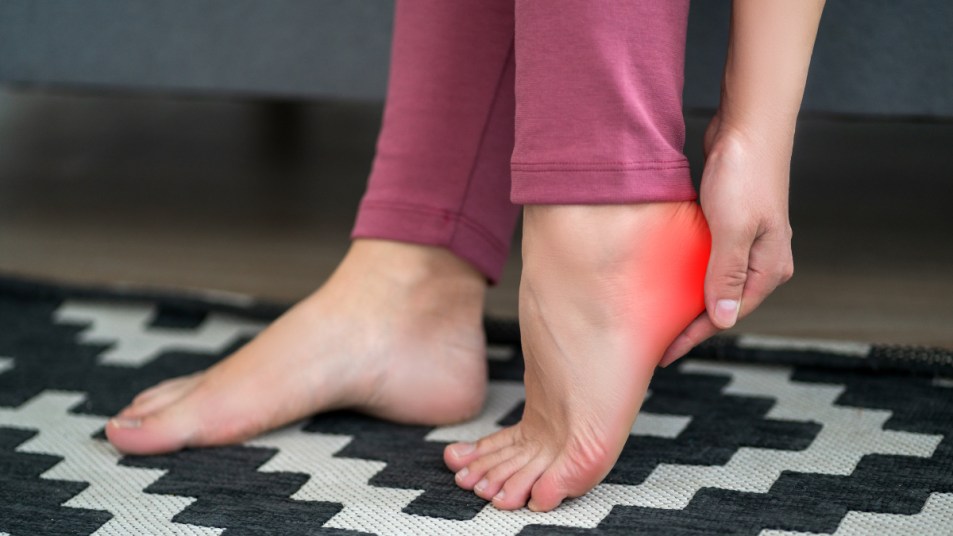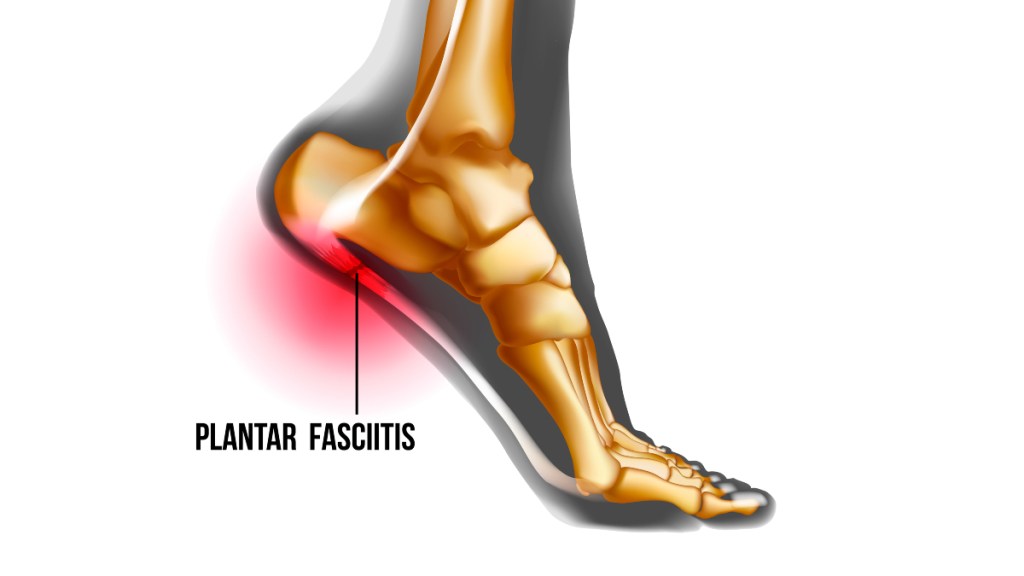How to Soothe Plantar Fasciitis Pain Fast: Podiatrist’s Ice Cup Massage Trick + More Home Remedies
Plus find out the exercise mistake almost everyone makes — and how to avoid it

If you’re experiencing a stabbing or burning pain in your heel or arch, a common condition known as plantar fasciitis could be the culprit. And when it flares up, every step can be painful. Wondering how to cure plantar fasciitis in a week so you can be ache-free ASAP? We asked the experts to share their best tips for getting fast relief from plantar fasciitis.
What is plantar fasciitis?
Plantar fasciitis is caused by inflammation of the plantar fascia, a thick band of tissue that connects your heel bone to the base of your toes. To find out exactly where the plantar fascia is, sit in a chair and rest one ankle on your opposite knee. Flex your foot and use one hand to gently bend the big toe back. Use the other hand and feel the bottom of your foot. “You will feel a tight band of tissue there — that’s the plantar fascia,” says Meredith Warner, MD, an orthopedic surgeon in private practice in Baton Rouge, Louisiana, and the inventor of The Healing Sole.
The plantar fascia helps to support the arch of your foot and absorb shock when you’re walking, running or jumping. But overusing or over-stretching this band of tissue can cause painful inflammation to develop. The pain from plantar fasciitis is often described as a stabbing or burning sensation near the heel. “It feels as if one’s heel stepped on a small stone or a Lego,” Dr. Warner says. “Most times, the pain is worse in the mornings and will improve during the day.”

Common causes of plantar fasciitis
Plantar fasciitis is one of the top triggers of foot pain. A few of the most common causes of the condition include:
- Age — plantar fasciitis commonly occurs between the age 40-60
- Obesity or sudden weight gain that puts extra stress on the feet
- Wearing unsupportive shoes
- Standing all day at work
- Arch problems such as flat feet or high arches
- A sudden increase in activity level
- Exercise that puts repetitive stress on the feet, like long-distance running or ballet
Before treating plantar fasciitis, it’s important to rule out other conditions that could be causing your foot pain. That can include Achilles tendonitis, sciatica or a stress fracture in the heel bone. You’ll want to visit a podiatrist, orthopedic specialist or physical therapist to determine what’s causing your foot pain and the best course of treatment.
How to cure plantar fasciitis in one week
When your heels are aching with each step you take, you’re going to want relief as soon as possible. But being completely pain-free from plantar fasciitis in one week is “usually unrealistic,” Dr. Warner says. In many cases, it takes a few months to make a full recovery from plantar fasciitis.
The only way to get immediate pain relief is through steroid injections, Dr. Warner adds, but there are some potential drawbacks. Research suggests steroid injections only provide short-term pain relief. And in small percentage of people, they could even lead to rupture of the plantar fascia.
The good news: While you may not be able to completely cure plantar fasciitis in one week, these simple at-home remedies can start easing the pain fast.
1. Relax with an A.M. bed stretch
Plantar fasciitis pain is often at its worst in the morning. That’s because your plantar fascia naturally tightens as you sleep. As you get out of bed and take your first steps of the day, the plantar fascia stretches, which can cause pain.
To prevent this, Alex Kor, DPM, a podiatrist with Hendricks Regional Health in Danville, Indiana, and the American Podiatric Medical Association, suggests doing the “Heel Cord Stretch” before getting out of bed. This lets you gently loosen the plantar fascia before putting any weight on it. Here’s how to do it:
- Sit with your left leg straight out in front of you and your right leg relaxed in any position that’s comfortable for you.
- Roll up a towel and wrap it around the ball of your left foot, grasping one end of the towel in each hand. Or use a stretching strap.
- Gently pull the towel or strap towards you until you feel a stretch in the bottom of your foot and your calf muscle.
- Hold this stretch for 30 seconds. Repeat five times on each side.

2. Try an ‘ice cup massage’
To help speed-cure plantar fasciitis, reach for ice — it can get you on the fast track to recovery. Dr. Kor suggests trying an “ice cup massage”, a targeted icing technique he says is even more effective than the age-old trick of rolling your foot on a frozen water bottle. What makes it superior? It allows you to apply targeted pressure directly around the plantar fascia to ease inflammation.
- Fill a small paper cup to the top with water and place it in the freezer.
- Once frozen, tear an inch or so off the top of the cup.
- Holding on to the bottom of the cup, massage the ice directly into your heel.
- Repeat for a total of 20 to 30 minutes each day.
Check out the video below for quick guide:
Tip: In between ice massage sessions, you can also help cure plantar fasciitis by loosening the plantar fascia muscle. One easy way to do so: Rolling a tennis ball or lacrosse ball under your foot for a deep tissue massage.
Dr. Warner recommends rolling for up to five minutes at a time, a few times a day, using as much pressure as you can tolerate. “Alternate between rolling lengthwise along the plantar fascia and rolling in circles,” she says. You can do this while sitting or standing, depending on how much pressure you want to apply. (Click through to see more foot massage benefits.)
For a visual guide, check out Dr. Warner’s how-to video below:
3. Apply KT tape for plantar fasciitis
One way athletes help cure a plantar fasciitis flare-up is by using kinesiology tape. This stretchy fabric tape helps to prevent injury, improve performance and provide support. You may hear people refer to it as KT Tape, Kinesio Tape or Rock Tape — a few of the most popular brand names.
“Kinesiology tape is a great tool for many musculoskeletal problems,” Dr. Warner says. “This tape provides tissue support and can reduce pain and swelling.” Kinesiology tape not only provides extra support to the muscles and joints, but research suggests it also lifts the skin to improve blood flow and lymphatic drainage.
When using kinesiology tape for plantar fasciitis, the “Low-Dye” taping method is considered the gold standard. To do:
- Wrap a piece of tape around the ball of the foot.
- Wrap a long piece of tape around the back of the heel and extending along both sides of the foot.
- Place strips of tape horizontally across the bottom of your foot, completely covering the bottom of your foot from heel to ball.
The tape should be replaced every three days, Dr. Warner says — or sooner, if it gets stretched out or starts to lose its effectiveness. And keep in mind that low-dye taping isn’t meant to be a long-term solution. “If it continues to be necessary to manage pain after about four to six weeks, there may be more going on, and a physician’s opinion should be sought,” Dr. Warner adds.
This TikTok video gives a step-by-step explanation of how to do this taping technique correctly:
@pcpersonalisedphysio Plantar Fasciitis Treatment: Low Dye Taping #plantarfasciitis #taping #footinjury #walking #heelpain #heelpainrelief #howtotape #physiotok how to tape for plantar fasciitis plantar fasciitis treatment plantar fascia pain heel pain as a physio physiotherapy rehab
♬ Pieces (Solo Piano Version) – Danilo Stankovic
4. Do the 5-second shoe test
“The number-one reason for plantar fasciitis is patients walking barefoot or wearing flimsy shoes,” Dr. Kor says. The best remedy for this, he adds, is to choose shoes with a rigid shank. The shank is the part of the shoe that runs lengthwise along your arch, halfway between the insole and outsole.
To see if your sneakers are rigid, simply hold the shoe by the heel and try to bend the toe box towards the heel. The middle of the shoe should stay rigid. If it flexes or folds easily, your sneakers may not be providing enough support, especially if you spend a lot of time on your feet. If you need extra support, browse our list of podiatrist-approved insoles for plantar fasciitis. And while at home, Dr. Kor recommends wearing recovery shoes to minimize the amount of time you spend walking barefoot.
5. Skip this exercise mistake
It may seem like the fastest way to cure plantar fasciitis is to stay off your feet. But as long as you’ve ruled out other possible causes such as a stress fracture, there’s no need to avoid exercise. In fact, too much rest can allow your plantar fascia to tighten, making the pain and inflammation worse.
“Keeping the foot strong by working the intrinsic muscles of the foot will help to maintain the strength and ability of the plantar fascia,” Dr. Warner says. “The exercises may be painful, but usually the pain of plantar fasciitis will improve with activity.” That’s because exercise helps to loosen the plantar fascia, which can reduce inflammation and prevent tearing. Staying active also helps with weight management, reducing the stress on your feet.

The best exercise to help cure plantar fasciitis
So what type of exercise is best for plantar fasciitis? First, Dr. Kor recommends skipping high-impact activities like running and jumping, which can aggravate plantar fasciitis. “Instead, one can do non-impact activities like swimming, using a stationary bike, elliptical or StairMaster,” he says.
With any exercise, the key is to listen to your body. “The age-old phrase ‘let pain be your guide’ generally holds true,” Dr. Warner says. “Most people will not go past a certain point of pain, and thus activity is self-limited to what the body can handle.” If the pain is intolerable, don’t push through it — that can prolong your healing time. And Dr. Warner cautions that the pain from a stress fracture will get worse with activity, not better. So if you find that exercise is making your feet hurt even more, be sure to talk to a doctor.
If you have a high-impact activity coming up that you don’t want to miss, like a pickleball game with friends or a local 5K, Dr. Warner recommends scheduling an appointment with a physical therapist. They can help you develop a stretching and strengthening regimen to ensure maximal healing before your event. (Click through to see the best pickleball shoes for women to help you stay supported while being active.)
For more ways to keep your feet pain-free and healthy:
Top of Foot Pain Is The Foot Problem No One Talks About — Doctors Reveal How to Outsmart It
Massage Pros Share Their Easy Moves for Your Best-Ever DIY Foot Rub + 6 Ways It Boosts Health Too
This content is not a substitute for professional medical advice or diagnosis. Always consult your physician before pursuing any treatment plan.
















